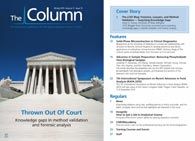Diagnosing Diabetes Using Amino Acid Profiling of Hair
Profiling amino acids in scalp hair could aid the diagnosis of type 2 diabetes, according to a new study. Researchers performed gas chromatography–mass spectrometry (GC–MS) on hair samples taken from diagnosed patients and healthy patients to show that type 2 diabetes alters the amino acid composition of hair’s main building block, keratin, and that this biomarker could aid diagnosis in the clinic.
Photo Credit: Anthony Lee/Getty Images

Profiling amino acids in scalp hair could aid the diagnosis of type 2 diabetes, according to a new study published in the journal Analytical Chemistry.1 Researchers performed gas chromatography–mass spectrometry (GC–MS) on hair samples taken from diagnosed patients and healthy patients to show that type 2 diabetes alters the amino acid composition of hair’s main building block, keratin, and that this biomarker could aid diagnosis in the clinic.
There are two types of diabetes, type 1 and type 2. Type 1 diabetes usually develops in childhood because of an underproduction of insulin, whereas type 2 diabetes develops because of insulin resistance in later life. According to the paper, because of this insulin resistance, amino acid update by cells is reduced resulting in a variation in freely circulating amino acids available for hair growth. Hair sampling is widely used in forensic investigations because it is noninvasive and hair samples can be stored for longer periods of time than blood or urine. The reason for this is that hair follicles in the scalp source freely circulating amino acids from the bloodstream, therefore newly grown hair reflects changes in these freely circulating amino acids over a period of time. Peter de B. Harrington from the University of Ohio told The Column: “The pilot study2 was an initial investigation if we could use amino acid profiling of hair to identify individuals for forensic investigative leads. From the survey results, we had a large collection of diabetic individuals, so we decided to see if we could identify this disease state from the amino acid profiles in hair.”
To investigate whether scalp hair contained biomarkers, scalp hair samples were taken from 27 people in Jordan - 15 were diagnosed with diabetes mellitus type 2. Hair samples were hydrolyzed using hydrochloric acid followed by amino acid derivatization using N,O-bis(trimethylsilyl)trifluoroacetamide (BSTFA) and subsequently analyzed by GC–MS. The nonessential amino acids Gly, Glu, and Ile were more abundant in the hair of diagnosed patients compared to control subjects.
Harrington told The Column: “There are two key phases for future work: find a faster and gentler method for digesting the hair and freeing the amino acids - we could only reliable observe 14/20, so being able to characterize all 20 would improve the informing power - [and] increase the size of the study so we have more individuals and validate the diabetic condition with blood tests.” - B.D.
References
- A.H.B. Rashaid, P.B. Harrington, and Glen P. Jackson, Analytical Chemistry (2015) DOI: 10.1021/acs.analchem.5b00460
- A.H.B. Rashaid, P.B. Harrington, and Glen P. Jackson, Analytical Methods 7, 1707–1718 (2015).

Common Challenges in Nitrosamine Analysis: An LCGC International Peer Exchange
April 15th 2025A recent roundtable discussion featuring Aloka Srinivasan of Raaha, Mayank Bhanti of the United States Pharmacopeia (USP), and Amber Burch of Purisys discussed the challenges surrounding nitrosamine analysis in pharmaceuticals.
Extracting Estrogenic Hormones Using Rotating Disk and Modified Clays
April 14th 2025University of Caldas and University of Chile researchers extracted estrogenic hormones from wastewater samples using rotating disk sorption extraction. After extraction, the concentrated analytes were measured using liquid chromatography coupled with photodiode array detection (HPLC-PDA).










